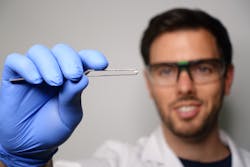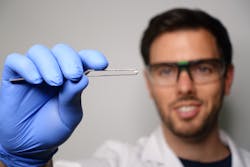Fine Bubbles Increase Hydrogen Production 50-Fold
Researchers in Erlangen, Germany, have discovered a way to increase by 50-fold the mass transfer in a heterogeneously catalyzed reaction. The development could play a central role in future hydrogen storage and transport technologies.
The researchers say their findings came about due to the nucleation of gas bubbles in the catalyst pore structure. They also found productivity increases significantly for this type of catalyst in gas-generation reactions when gas bubbles form easily in the catalyst pores.
“This additional factor, which significantly determines the reaction rate, was previously unknown,” says Peter Wasserscheid, professor and director of the Helmholtz Institute Erlangen-Nürnberg for Renewable Energy and head of chemical reaction engineering at Friedrich-Alexander-Universität Erlangen-Nürnberg. “Until now, it was assumed that the reaction rate was determined only by the chemical surface reaction or by the transport of molecules to the active centers of the catalyst.”When the researchers made their findings, they were investigating catalytic hydrogen release from the liquid organic hydrogen carrier (LOHC) compound perhydro-dibenzyltoluene — a reaction they believe is of the highest relevance for the future green-hydrogen economy.
The researchers determined a nucleation-inhibited catalytic system produces only dissolved hydrogen with fast saturation of the fluid phase around the active site, while bubble formation enhances mass transfer by more than a factor of 50 in an oscillating reaction regime. Nucleation can be efficiently triggered not only by mechanical stimulus but also by temperature changes and catalyst surface modification.
Bubbles in the catalyst pores are acting like tiny pumps, says Wasserscheid, helping to remove the released hydrogen. Once a bubble has formed in a catalyst pore, as it grows it collects hydrogen formed there. When the bubble then detaches into the surrounding liquid, the loaded hydrogen carrier flows back into the pore and the process starts all over again.
The work appears in a recent issue of Science Advances, where in the “competing interests” section, Wasserscheid is named as a founder and a minority shareholder of the company Hydrogenious LOHC Technologies, also in Erlangen, and offering commercial hydrogen storage systems based on LOHC technology. He and the other authors also are listed as inventors of two patent applications related to the preparation of catalyst material for the dehydrogenation and/or hydrogenation of a hydrogen carrier material, and to the release of a gas from a carrier material.
About the Author
Chemical Processing Staff
Chemical Processing's editors cover industry news relevant to readers. You can email your news items to Editor-in-Chief Traci Purdum at [email protected].

